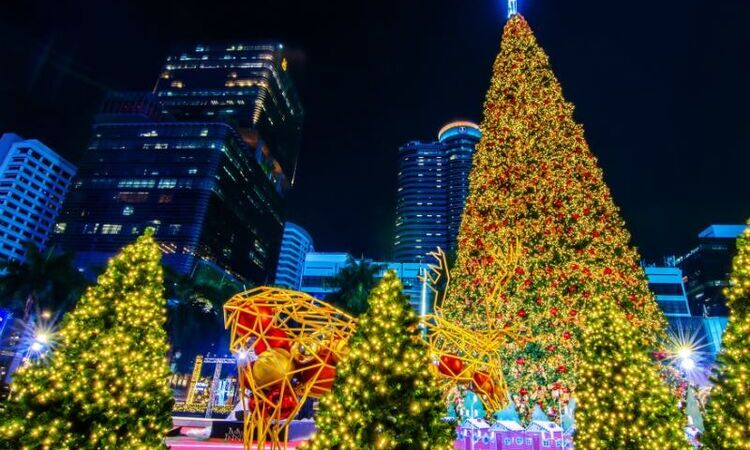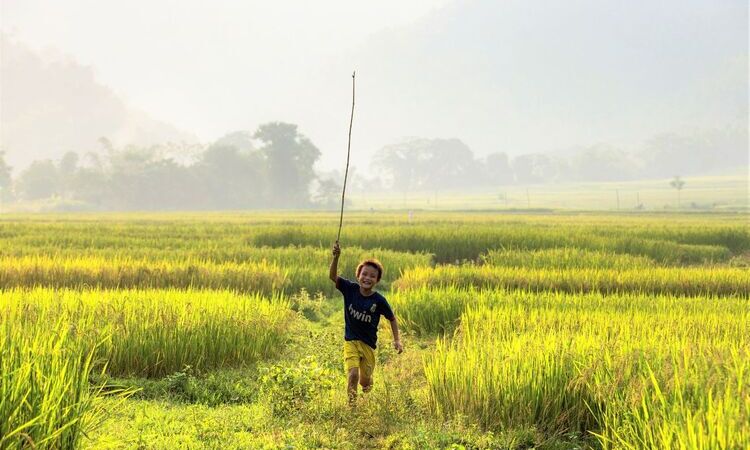Southeast Asian Festivals by Month
At any time of year, you can experience amazing Southeast Asian festivals. Discover top festivals in Laos, Vietnam, Indonesia, and Thailand.
Among the many draws of visiting Southeast Asia are the wondrous festivals that take place throughout the year. In fact, no matter what month you are visiting, you should be able to experience at least one Southeast Asian festival. Let’s take a look at the top festivals to experience in Laos, Vietnam, Thailand, and Indonesia month by month.
Jan - Bun Pha Vet in Laos
Bun Pha Vet is the Laos regional variation of the Vessantara Festival, sometimes also spelled as “Boun Phavet.” It spans three days and nights in January.

The festival celebrates the life and reign of King Phavet (Vessantara), who was famous for giving away everything he owned. While he was being banished, an elephant he gave away turned out to be lucky, and eventually brought rain, ending a famine. Phavet was allowed to come back home and rule again. In a future life, Phavet had a family again but left his wife to become an enlightened monk.
During the Bun Pha Vet festival, monks in Laos read this story. They may also be ordained during this time, as it is considered to be lucky. There are processions with drums and dancing; which symbolize Phavet’s return from exile.
Feb - Tết in Vietnam
If you will be in Vietnam in February, you can experience the Tết Nguyên Đán festival, often simply referred to as Tết.

No other festival is as crucial to Vietnamese culture as this one, which welcomes the Lunar New Year according to the Vietnamese calendar. During the week of the festivities, a dazzling array of sights and sounds awaits you. Parades featuring lion dancers ward away evil spirits, creating a bold, colorful spectacle. If you want to add to their efforts, you can use a gong, bell, or other loud items to help scare the evil spirits away.
As revelers stave off bad luck, they also invite good luck. It is tradition for elders to give children money in red envelopes during Tết Nguyên Đán, ushering in fortune and prosperity.
Quite a few traditional foods are associated with the Lunar New Year in Vietnam. Examples include bánh chưng and bánh tét (dong leaves, sticky rice, and meat or beans), hạt dưa (roasted watermelon seeds), and thịt kho nước dừa (meat stewed in coconut juice).
2024 Tet celebration: February 10th (1st day of Lunar New Year)
Mar - Nyepi in Indonesia
While you are in Bali, you may experience the “Day of Silence” in March, known as Nyepi. This Hindu celebration is one for deepening spirituality through meditation and fasting. To ensure that everyone can spend the day in meditation, people are not allowed to access the web, TV or radio for entertainment. It is quite literally a silent day.

Leading up to Nyepi, you can witness the Melasti Ritual and the Bhuta Yajna Ritual, as well as the Pengrupukan ceremony. Additional rituals follow the Day of Silence. By completing the rituals, those who observe Nyepi drive out evil spirits and usher in the future.
At a glance, it might be hard to see what the draw of Nyepi would be for a tourist. But many people who have visited Bali report it was the most incredible experience they had there. During this Southeast Asian festival, you can gaze up at the stars with only the sounds of nature to break the silence, basking in stillness and tranquility that many people around the world will never experience. It may be one of the most awe-inspiring days of not just your trip, but your life as well.
2024 Nyepi celebration: March 11th - 12th
Apr - Songkran Water Festival in Thailand/Pi Mai in Laos
During April, a pair of festival delights in Thailand and Laos: the Songkran Water Festival, and Pi Mai, respectively.

Both of these festivals take place from April 13th through April 15th, in recognition of the New Year. This is your chance to participate in the world’s biggest water fight! Major roads are closed to automobiles so that people can go out and soak one another. Use a water gun or even a bucket—and get ready to get drenched!
Thailand and Laos are really hot at this time of year, so you’ll probably find a blast of water to be a relief. It dries off quickly as well, so you will not need to walk around dripping all day. While the water fights are the most famous part of Songkran and Pi Mai, these festivals also involve making sand stupas (pagodas made of sand), setting animals free, decorating with flowers, and more.
May - Boun Bang Fai Rocket Festival
Boun Bang Fai is a Laotian Buddhist festival that takes place in both Laos and the northeastern region of Thailand. It is an agricultural festival with origins in fertility rites performed to summon rain for growing rice.

Over the course of several days, visitors to Laos and Thailand can enjoy processions featuring beautiful floats accompanied by song and dance. But it is on the final day of the Southeast Asian festival that the most unique event takes place: rocket launching.
Celebrants craft rockets out of bamboo and then fire them skyward. The idea is that Phaya Thaen, the rain god, will see them, up in his heavenly abode. Everyone tries to get their rockets as high as they can, both to maximize their chances of reaching the god and to beat their competitors for bragging rights.
2024 Boun Bang Fai celebration (estimation): May 10th - 13th
Jun - Phi Ta Khon in Thailand
The Buddhist festival Phi Ta Khon is known as the “Ghost Festival.” To experience it, pay a visit to Dan Sai in the Loei Province. Usually, the festival takes place during three days in June, but may be held as early as March or as late as July.

Like Bun Pha Vet, this festival commemorates the story of Vessantara. During his exile, his loyal adherents feared he was dead. Upon his return, they rejoiced; it was as if he had arisen from the grave.
So, during Phi Ta Khon, celebrants don colorful costumes and distinctive long-nosed ghost masks. Then they parade through town, connecting with the spirit world.
Participants often sell their masks after the celebration ends. This is your opportunity to bring home a one-of-a-kind souvenir by a local artisan.
Jul - Bali Kite Festival
July marks the beginning of the famous Bali Kite Festival, taking advantage of the windy season. Marvel as teams of up to 80 people launch massive kites, many of them longer than 30 feet and shaped like birds, fish, and leaves. The festival can last until October.

Believers hope that the huge kites flying high will catch the eyes of the gods, who in turn will know their followers are grateful for the blessings they have bestowed upon them.
As a guest in Bali, you can try launching a kite of your own during the festival, or you can simply watch in wonder as the breathtaking kites around you take to the skies.
Aug - Hungry Ghost Festival
The Hungry Ghost Festival is celebrated in China, Singapore, Malaysia, Indonesia, Taiwan, Japan, and Vietnam, with related festivals in Cambodia, Sri Lanka, Laos, India, and Thailand.

Those who observe this festival believe that the worlds of the dead and living are connected during this time, making contact between living people and spirits possible—for good or for ill.
To appease the dead, they burn incense and make offerings. As they literally believe the ghosts are hungry, many of these offerings are food.
Perhaps the most magical sight during the Hungry Ghost Festival is the lotus lanterns aglow on the rivers at night. These lanterns act as beacons. Souls lost in the world of the living can follow them home to their afterlives.
2024 Hungry Ghost Festival celebration: August 18th
Sept - Mid-Autumn Festival Vietnam
Another festival in S.E. Asia that features atmospheric sights after the sun goes down is the Mid-Autumn Festival in Vietnam. This festival is a chance to rejoice at the abundance of a bountiful harvest.

Also called the “Moon Festival” or “Mooncake Festival,” variants of the Mid-Autumn Festival are celebrated in China, Japan, Korea, Singapore and Indonesia as well. In Vietnam, it is known as “Tết Trung Thu.” Sometimes it is referred to as the “Children’s Festival.”
Tourists can eat beautiful, delicious mooncakes during the festival and venture out after dark to behold countless colorful lanterns on parade. Mid-Autumn Festival lanterns often are shaped like stars, but they can also feature flowers, animals, zodiac signs, and other imagery.
You can watch the performances of dragon and lion dancers as they chase away evil spirits while welcoming in prosperity and fortune. The colorful costumes, mesmerizing movements, and lively beats offer a dazzling spectacle.
2024 Mid-autumn festival celebration: September 17th
Oct - The Phuket Vegetarian Festival – Phuket, Thailand
Also known as the “Nine Emperor Gods Festival,” the Phuket Vegetarian Festival is one of abstinence and purification. If you see red and yellow flags outside of certain restaurants and stores, that means they are serving vegan food suitable for the event.

Some participants in the festival enter a trance state and ritualistically undergo temporary mutilations, usually involving skewering their flesh with sharp implements.
Westerners may get puzzled or disturbed by some of what they see. But it is important to know that safety measures are taken when performing these rituals and that those engaging in them are doing something positive, cleansing, and uplifting.
2024 Phuket Vegetarian Festival celebration: October 3rd - 11th
Nov - Loy Krathong and Yi Peng
While learning about festivals in Southeast Asia, you have probably seen photographs of hundreds or thousands of paper lanterns floating up into the night sky. Typically, these photos are snapped during the Thai Lantern Festival. This festival consists of two variants: Loy Krathong and Yi Peng.

The word “loy” means “to float.” During Loy Krathong, participants float lanterns along lakes and rivers. Yi Peng is the variant where the lanterns are released to float up into the sky.
The Thai Lantern Festival unites multiple faiths and traditions. The festival pays homage to Buddha, the goddess Phra Mae Khongkha, Lord Vishnu, and a Buddhist monk named Upagupta. Many who release lanterns during the festivities are also doing so to connect with their ancestors.
While floating the lanterns, celebrants may seek purification and forgiveness for past misdeeds, express gratitude for their blessings, and pray for fortune in the year ahead.
2024 Thai Lantern Festival celebration: November 15th
Dec - Hmong New Year – Laos, Vietnam, and Thailand
Hmong New Year is a five-day festival celebrated in Laos, Vietnam, and Thailand, marking the end of one year and the start of the next. It is a festival of the Hmong people, one of dozens of ethnic groups that reside in this part of Asia.

During the Hmong New Year, people dress up in colorful traditional clothes. The festival features a wide range of activities, including playing games with tops or balls, playing an instrument called a “Khen,” bullfighting, and more. The Hmong people also eat a special rice cake during this time called “Banh Giay.”
This is also an occasion when it is popular for Hmong individuals to pick partners and even get married. The Hmong spend a great deal of time out in the fields, so this time for celebration and rest is a convenient one for establishing lifelong partnerships.
*** There can be a slight difference in the celebration time of these festivals due to local time calculation.
Join in the Festivals of Southeast Asia
No matter when you are planning to visit Southeast Asia, you can find opportunities to immerse yourself in the local culture and join in the spirit of celebration and devotion. Design your trip with Exotic Voyages.





